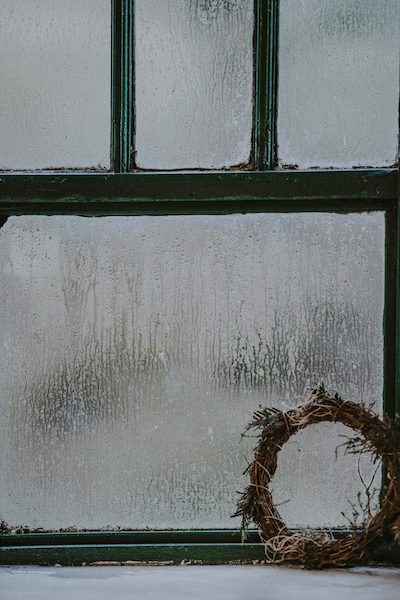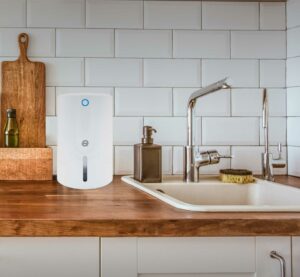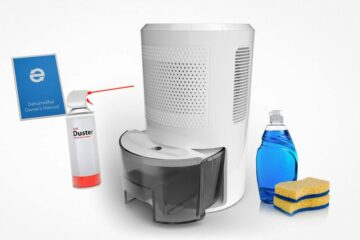Dehumidifiers. You’ve noticed them in the corner of basements, heard about them, and finally, you decided that you needed one for your own home and went out and got one. You know the basics of what they do solely based on the name… they dehumidify. However, now you’re asking yourself, “how do I use this thing”.
There’s a happy medium between your home feeling like a tropical rainforest and a desert. That being said, we’re here to help. We’re going to teach you about dehumidifier settings and the proper way to set yours for optimum performance.
Dehumidifier Settings: What Are They?
Most dehumidifiers offer similar settings that make it easy and intuitive for you to set. It is pretty standard to see some type of gauge indicating the water level inside the reservoir, an adjustable panel that allows you to adjust the humidity setting that you desire and fan speed (low to high).
Additional advanced settings offered by some models may include timers, variable settings where you can toggle humidity based on time of day and some may even offer some kind of voltage gauge depending on the model. Again, these aren’t standard, but some advanced options that different models may offer.
What Are the Right Dehumidifier Settings for You?
The most critical setting for you and your home is going to be the humidity setting. Specifically, you’re going to be concerned with the relative humidity.
Relative Humidity Explained
Relative humidity refers to how much moisture is in the air as compared to how much moisture the air is capable of holding.
Here’s an example: A reading of 100% relative humidity means that the air is saturated with water vapor and cannot hold more.
The Optimal Level of Humidity in a Building is Between 30-50%

According to Energy Star’s dehumidifier basics, the optimum level of relative humidity for a building is generally considered to be between 30% and 50%.
Anything above this range may cause moisture-related issues. In colder climates, during the heating season, humidity levels should be in the field of 30% to 40% relative humidity to prevent window condensation.
Note*: When we say humidity setting, we are referring to what you are setting your desired humidity in the room to.
While many dehumidifiers have a reading that measures the current humidity in the room, some do not.
Your dehumidifier may not have a setting that tells you the current humidity. If so, you can buy and place a hygrometer in the room to serve that function and help you calibrate your settings correctly.
More Advantages of Humidity Control
Here are other advantages of keeping your home within the 30-50 percent humidity level:
- Decreases favorable conditions for cockroaches
- Prevents the house or other space from smelling stale or musty
- Protects furniture and valuables (certain items may require a specific humidity percentage to stay preserved)
- You feel more comfortable
Note*: There is such a thing as too much of a good thing. If humidity levels drop below 30 percent you’ll start to notice dry skin, and it can damage furniture and other valuables and it will cause general discomfort.
How Seasons Affect Your Settings
Running your dehumidifier in different seasons can be a bit tricky. During warmer months, there usually isn’t a problem with running a dehumidifier because there is typically more moisture in the air during this time.
However, during the winter, you have to consider a few things:
- Your dehumidifier attracts moisture if it gets too cold. If that happens, the water your machine collects could potentially freeze and damage your device.
- Another consideration when running your dehumidifier in the winter is that humidity levels naturally drop when temperatures drop. Try to watch the levels displayed by your dehumidifier or your hygrometer: too high humidity leads to issues, but too low can also cause problems. (This can especially come into play in places such as basements and crawl spaces).

3 Other Things to Consider When Choosing Your Dehumidifier Settings
Aside from your humidity levels, here are some tips on how to get the most out of your dehumidifier.
1. Your Whole Home Requires More Than One Dehumidifier

One dehumidifier placed in your basement won’t be able to cover your entire house. Instead, we recommend strategically placing them around the home in the areas where the most moisture is present.
2. Avoid Setting Dehumidifiers Against Walls
Additionally, make sure your dehumidifiers are NOT sitting against any walls. Always remember to place dehumidifiers a few inches away from the wall to ensure your device receives proper airflow.
3. Remember to Drain Your Collection Device
Your machine will shut off when the water collection reservoir is full. Therefore, remember to drain your collection device if your dehumidifier drain is not already connected to a hose or other disposal mechanism.
Controlling Moisture and Humidity with Eva-Dry
Eva-Dry is on the leading edge of dehumidification technology and understands how important it is to maintain good indoor air quality to support health, keep your family comfortable, and keep your property free of moisture damage. Eva-Dry’s renewable dehumidifiers work by removing moisture from the air using natural desiccant materials. These dehumidifiers are safe, non-toxic, and produce no odor.
Investigate our full line of products and contact one of our knowledgeable consultants today about the humidity, or condensation issues you may be experiencing. For more information about dehumidifier issues or controlling humidity, refer to our other blog posts here.
What Basement Dehumidifier Settings Do I Use?
Before using your dehumidifier anywhere, you need to know the relative humidity. If you don’t have a good idea of what that is, use a hygrometer. Your basement dehumidifier setting should most likely be at max and left on. If you’re using a small electric dehumidifier, don’t forget to empty the tray regularly.
If you’re worried about overusing the dehumidifier, use the hygrometer and make sure it’s not under 15% and turn down the settings if you can.



Can I use my unit as a pre-heater in my car’s interior on chilly winter mornings?
Which unit do you own?